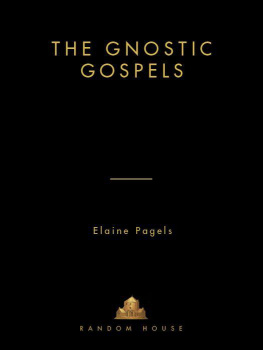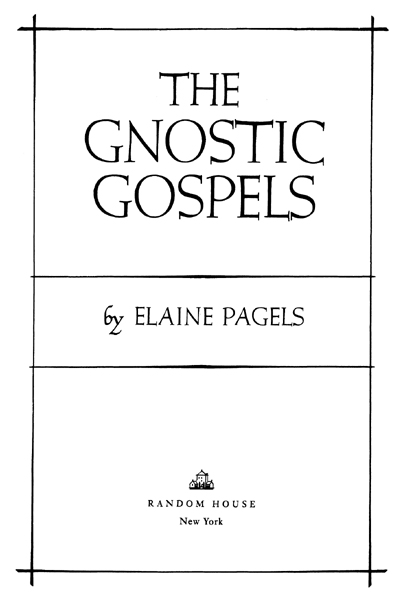Also by Elaine Pagels
T HE J OHANNINE G OSPEL IN G NOSTIC E XEGESIS
T HE G NOSTIC P AUL : G NOSTIC E XEGESIS
OF THE P AULINE L ETTERS
A DAM , E VE, AND THE S ERPENT
T HE O RIGIN OF S ATAN
B EYOND B ELIEF : T HE S ECRET G OSPEL OF T HOMAS
Copyright 1979 by Elaine Pagels
All rights reserved under International and Pan-American Copyright Conventions. Published in the United States by Random House, an imprint of The Random House Publishing Group, a division of Random House, Inc New York, and simultaneously in Canada by Random House of Canada Limited, Toronto.
R ANDOM H OUSE and colophon are registered trademarks of Random House, Inc.
Since this page cannot legibly accommodate all acknowledgments to reproduce previously published material, they appear on the opposite page.
LIBRARY OF CONGRESS CATALOGING-IN-PUBLICATION DATA
Pagels, Elaine H.
The gnostic Gospels.
1. Gnosticism. 2. Chenoboskion manuscripts.
I. Title.
BT1390.P3 2731 79-4764
eISBN: 978-1-58836-417-3
Random House website address: www.atrandom.com
v3.1
Grateful acknowledgment is made to the following for permission to reprint previously published material:
Division of Christian Education of the National Council of the Churches of Christ in the U.S.A.: Excerpts from the New Testament. The Scripture quotations in this publication are from the Revised Standard Version of the Bible, copyrighted 1946, 1952, 1971, 1973 by the Division of Christian Education of the National Council of the Churches of Christ in the U.S.A., and used by permission.
Wm. B. Eerdmans Publishing Co.: Excerpts from Tertullian, Iranaeus and Hippolytus. Reprinted from The Ante Nicene Fathers by permission of the Wm. B. Eerdmans Publishing Co., Grand Rapids, Michigan.
Harper & Row, Publishers, Inc.: Excerpts from The Nag Hammadi Library by James M. Robinson. Copyright 1977 by E. J. Brill, Leiden, The Netherlands. Reprinted by permission of E. J. Brill and Harper & Row, Publishers, Inc.
Harvard University Press: Excerpts from Clement and Ignatius, in The Apostolic Fathers, 1912, The Loeb Classical Library, translated by Kirsopp Lake. Reprinted by permission of Harvard University Press.
Lutterworth Press and The Westminster Press: Excerpts from New Testament Apocrypha, Volume I, edited by Wilhelm Schneemelcher and Edgar Hennecke. English translation edited by R. McL. Wilson. Published in the U.S.A. by The Westminster Press, 1963. Copyright 1959 J. C. B. Mohr (Paul Siebeck), Tbingen. English translation 1963 Lutterworth Press. Excerpts from New Testament Apocrypha, Volume II, edited by Wilhelm Schneemelcher and Edgar Hennecke. English translation edited by R. McL. Wilson. Published in the U.S.A. by The Westminster Press, 1966. Copyright 1964 J. C. B. Mohr (Paul Siebeck), Tbingen. English translation 1965 Lutterworth Press. Used by permission.
Oxford University Press: Excerpts from The Acts of the Christian Martyrs, translated by Herbert Musurillo. Copyright Oxford University Press 1972. Reprinted by permission of Oxford University Press.
To Elizabeth Diggs and Sharon Olds
in loving friendship
ACKNOWLEDGMENTS
T HE WRITING of this book began several years ago with research into the relation between politics and religion in the origins of Christianity. The first four chapters have been published in more technical form in scholarly journals (specific references precede the footnotes of each chapter).
In preparing this volume I have generally chosen to follow the translations offered in The Nag Hammadi Library, edited by James M. Robinson, since these are readily available to all readers. In certain cases, however, I have changed the translation for the sake of clarity, consistency or interpretation (for example, I have translated the Coptic transliteration of the Greek term  not as perfection, but as fulfillment, which seems to me more accurate; in other cases, where the Coptic term
not as perfection, but as fulfillment, which seems to me more accurate; in other cases, where the Coptic term  apparently translates the Greek
apparently translates the Greek  I have translated it not as man but as humanity). In the case of two texts, I have used different translations (see below).
I have translated it not as man but as humanity). In the case of two texts, I have used different translations (see below).
I am especially grateful to those colleagues and friends who have read and criticized the entire manuscript: Peter Berger, John Gager, Dennis Groh, Howard Kee, George MacRae, Wayne Meeks and Morton Smith. For other advice and criticism, specifically of aspects of the introduction, I owe grateful thanks to Marilyn Harran, Marvin Meyer, Birger Pearson, Gilles Quispel, Richard Ogust and James M. Robinson. I am grateful, too, to Bentley Layton for permission to use his translation of the Treatise on Resurrection, and to James Brashler for permission to use his translation of the Apocalypse of Peter.
Special thanks are due the Rockefeller Foundation, the Lita A. Hazen Foundation and the Guggenheim Foundation for their support, which granted me the time to devote to writing; and to President Jacqueline Mattfeld and Vice President Charles Olton for approving a years leave from my responsibilities at Barnard College. Especially I wish to thank Lydia Bronte and Lita A. Hazen for their encouragement throughout the whole project.
The present version of the book would have been impossible to produce without the superb editing of Jason Epstein, Vice President and Editorial Director of Random House; the excellent advice of John Brockman; and the conscientious work of Connie Budelis in typing and Barbara Willson in copyediting.
Finally, I wish to thank my husband for his loving encouragement in the process of this work.
CONTENTS
INTRODUCTION
I N D ECEMBER 1945 an Arab peasant made an astonishing archeological discovery in Upper Egypt. Rumors obscured the circumstances of this findperhaps because the discovery was accidental, and its sale on the black market illegal. For years even the identity of the discoverer remained unknown. One rumor held that he was a blood avenger; another, that he had made the find near the town of Naj Hammd at the Jabal al-Trif, a mountain honeycombed with more than 150 caves. Originally natural, some of these caves were cut and painted and used as grave sites as early as the sixth dynasty, some 4,300 years ago.
Thirty years later the discoverer himself, Muammad Al al-Sammn, told what happened.and loose papyrus leaves on the straw piled on the ground next to the oven. Muammads mother, Umm-Amad, admits that she burned much of the papyrus in the oven along with the straw she used to kindle the fire.















 not as perfection, but as fulfillment, which seems to me more accurate; in other cases, where the Coptic term
not as perfection, but as fulfillment, which seems to me more accurate; in other cases, where the Coptic term  apparently translates the Greek
apparently translates the Greek  I have translated it not as man but as humanity). In the case of two texts, I have used different translations (see below).
I have translated it not as man but as humanity). In the case of two texts, I have used different translations (see below).